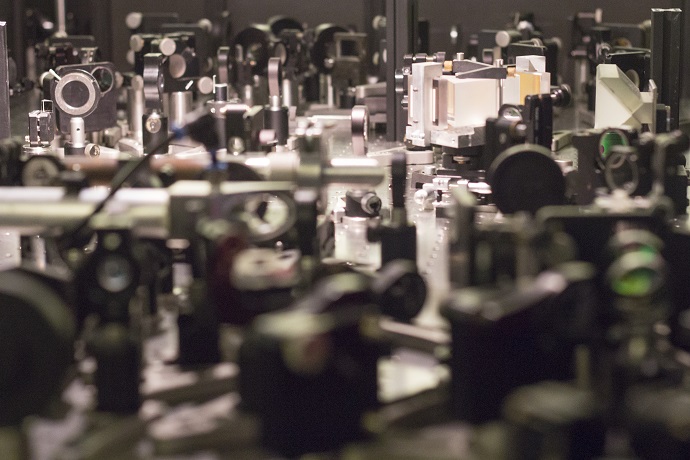2014-11-11
X-rays are widely used in medicine and in materials science. To take a picture of a broken bone, it is enough to create a continuous flux of X-ray photons, but in order to study time-dependent phenomena on very short timescales, short X-ray pulses are required. One possibility to create short hard X-ray pulses is hitting a metal target with laser pulses. The laser rips electrons out of the atoms and makes them emit X-ray radiation. Electrical engineers at the Vienna University of Technology (TU Wien) together with researchers from Berlin have drastically increased the flux of X-ray photons using a newly developed mid-infrared laser system. This new table-top X-ray source will allow more accurate measurements in many fields of research.
Long Waves and Short Waves
Hard x-ray radiation is light with a wavelength in the range of picometers – much shorter than the wavelength of visible light. But in order to create this extremely short wave radiation, Professor Andrius Baltuska’s team (Photonics Institute, Electrical Engineering, TU Wien) starts out with a quite different kind of light. They created a high-intensity infrared laser system with a wavelength of 4 micrometers – which is a wavelength much longer than visible light.
The mid-infrared light emitted by the laser hits a copper plate. The intensity of the laser light is so high that electrons are ripped out of the atoms. The laser field turns them around, accelerates them and eventually makes them hit the copper again at very high energies. During this impact of the electrons returning to the copper plate, X-ray radiation is emitted.
“The flux of the x-ray radiation depends on the wavelength of the laser”, says Skirmantas Alisauskas (TU Wien). “If the laser wavelength is long, then every electron spends a lot of time in the laser field before it returns to the copper atoms. It has more time to gain energy and hits the copper plate even harder.”
Building a New Kind of Laser
This is why the scientists have focussed their attention on building long-wavelenth laser systems. “Previously, this experiment was done with a common 0.8 micrometer laser. The wavelength of our laser pulses is five times as long, which translates into a 25 times higher x-ray flux”, says Skirmantas Alisauskas. Each laser pulse leads to one billion x-ray photons, emitted into all directions.
Creating this laser light was a big technological challenge. “Building lasers with such long wavelengths is hard, but the main problem was making the laser light intense enough”, says Alisauskas. “At this wavelength, this is the most intense laser light in the world. But we want to go even further in the near future.”
More Pulses per Second
The team is planning to go to even longer wavelengths, and they are trying to increase the rate at which the laser can produce light pulses. “At the moment, we have a repetition rate of 20 laser pulses per second. That is perfectly fine for a proof of principle, but for technological applications we need to increase that – and we already have a few good ideas of how to do this”, says Prof. Andrius Baltuska.
X-rays are used whenever the atomic structure of materials has to be investigated. As the new x-ray source does not produce a continuous beam but short pulses, it can be used for time-resolved measurements.

Creating Bright X-Ray Pulses in the Laser Lab
A newly developed laser system allows scientists at the Vienna University of Technology (TU Wien) to create high flux X-rays.

Optical table at the Photonics Institute (TU Wien)










